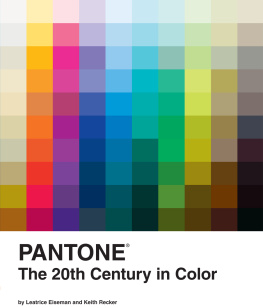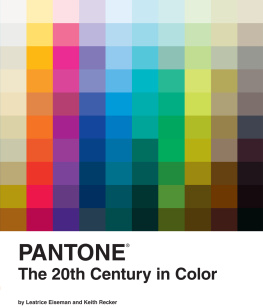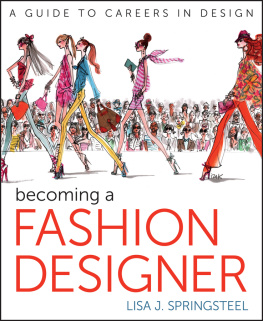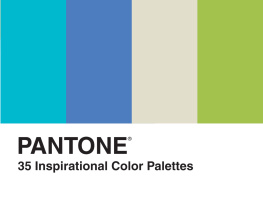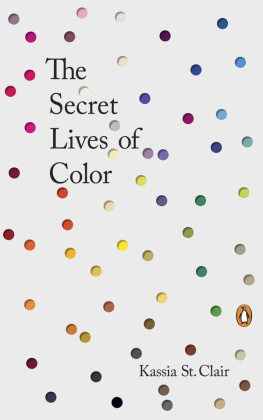
The authors wish to thank: Frank Burrafato, Yolanda Cazares, Julie Chen, Joyce Corrigan, Brian Cottle, Herb Eiseman, Gretchen Fenston, Stefan Freed, Bobbie Hawkes, Lisa Herbert, Tim Heyer, Brooke Johnson, Caitlin Kirkpatrick, Karen Lantelme, Bob Lynn, Christine L. Mace, Gena McGregor, Ellen Pinto, Lynne K. Ranieri, Leigh Saffold, Judy Theuerkauf, Gnyuki Yuki Torimaru, Elizabeth Vitiello, Shawn Waldron, and Bridget Watson Payne, as well as their supportive family and friends.
Text copyright 2014 by Pantone LLC.
All rights reserved. No part of this book may be reproduced in
any form without written permission from the publisher.
constitute a continuation of the copyright page.
Front cover image: Coat, Bottega Veneta; German Vogue,
November 2013; Photographer, Julia Noni/Trunk Archive;
Model, Hailey Clauson/One Management
Library of Congress Cataloging-in-Publication data available.
ISBN: 978-1-4521-1535-1 (hc)
ISBN: 978-1-4521-3052-1 (epub, mobi)
Designed by Brooke Johnson
Typesetting by DC Typography
PANTONE Color identification is solely for artistic purposes
and not intended to be used for specification. Refer to current
PANTONE Color publications for accurate color. PANTONE
and the Pantone Chip Designs are trademarks of Pantone LLC
in the United States and/or other countries. This is an authorized
PANTONE UNIVERSE product manufactured under
license by Chronicle Books LLC.
Chronicle Books LLC
680 Second Street
San Francisco, CA 94107
www.chroniclebooks.com
Introduction
The story of fashion is the story of color. More than any other single factor, color gives a garment (and the person who wears it) impactboth visual and emotional. A woman walking toward you in a red dress tells a very different story than the same woman in blue. Yet, the twin stories of fashion and color are rarely woven together. Everyone knows that color trends are a large part of fashion, but their importance goes far beyond the seasons must-have color. Charted and studied over chunks of time, fascinating patterns and repetitions emerge. The fugitive nature of color speaks to the ephemerality of existence. Bold Fuchsia pops up only to hibernate for prolonged periods of time, whereas classic Navy is ever present. This book is an attempt to track and illuminate these historical color stories in the world of fashion.
Though we look here primarily at fashion and color in the 20th and early 21st centuries, the further pasteven as far back as ancient historystill echoes today.
Cochineal red, historically associated with blood, fire, fertility, and life force, still exudes sexuality and danger. The alchemy of indigo, a green plant that produces a blue dye, is still revered. Purpuridae, a purple dye, which took hundreds of thousands of mollusks to produce one ounce of, still conveys wealth and drama. Our deep-seated associations with colors linger, even when technological innovations render obsolete the original artisanal processes by which clothing was dyed these shades. Our era is unique in that the emergence of synthetic dyes in the mid-1850s has since allowed for a previously unseen democratization of color; the veritable rainbow now available for all.
When delving into the history of fashion and its relationship to color, it becomes apparent that its history is inherently intertwined with history at large. Why people wear what they wear is influenced by events, local and global, political and cultural. The wars of the 20th century and beyondfrom World War I, World War II, and the Vietnam War to the Gulf War and the wars in Iraq and Afghanistanall affected the use of color in fashion. The eras of jazz, glamorous Hollywood, the nifty 50s, the youth-quake, the hippie movement, the opulent 80s, the grunge 90s, and the new millennium were all also visually represented by colors in fashion.
The meaning of certain colors changes over time. White, traditionally associated in the West with virginity, took on a different type of purity during the mid-20th century when it became the modernists color of choice. Once funereal, black became known in succession as chic, classic, sexy, and then existential, in the hands of Gabrielle Coco Chanel, Hubert de Givenchy, Azzedine Alaa, and Yohji Yamamoto, respectively. One color could possess a singular meaning at the turn of the 20th century, only to twist and turn through numerous, disparate meanings by the dawn of the 21st.
Impermanent fads sped up in the modern era as fashion became increasingly available, affordable, and fast. Fashion was one of the first global industries (as antiquated trading routes prove), but the phenomenon of globalization nevertheless altered it. As production shifted to developing countries with lax labor laws and no minimum wage, both fashions ethics and its pace changed radically.
But although these rapid shifts did occur in fashion and color during the 20th century, it behooves us to bear in mind, as Colin McDowell argues in his book Fashion Today, that the basic premises of fashion actually change quite slowly. McDowell asserts: It is possible to say of twentieth-century fashion that there have been only two serious permanent changes: the move from long skirts to short and the adoption of trousers by women. McDowells point should be noted, and fashion considered within a vast historical context, akin to Charles and Ray Eamess film Powers of Ten. In the grand scheme of history, fashion does move more slowly than the public believes.
In looking at what colors were worn when and attempting to determine why, we examine historical context and explore the designers who chose them. While many of the designers names will be familiarlike Ralph Lauren, Donna Karan, and Calvin Kleinweve blown off the dust of forgotten nameslike Augusta Bernard, Sydney Wragge, and Gnyuki Torimaruas well, bringing the garments they designed out of the archives, as it were, and re-examining their significance. History, which continues to edit itself, highlights some and ignores others. To combat this, some of the big-name designers may not be covered, and some of the lesser known illuminated. We let the colors lead the way and be our guide, and that means that this book is by no means exhaustive. Perhaps future works can include, in no particular order, Nicolas Ghesquire, Hussein Chalayan, Veronique Branquinho, Olivier Theyskens, Arnold Scaasi, Erdem Moraliolu, Haider Ackermann, Damir Doma, the Callot Soeurs sisters, Cdric Charlier, Phillip Lim, Karen Walker, et al.
But dont fret! Some designers have become nearly synonymous with specific colors and they, of course, are included. A work on fashion and color would be incomplete without sections on Elsa Schiaparelli and her Shocking Pink, Valentino and his signature red, and the use of black by Yohji Yamamoto and Comme des Garons Rei Kawakubo (whose predilections for it earned them the respective nicknames The Monk and The Nun).
Many myths exist about fashion and its relationship with color. Unfortunately for the more sensationally minded among us, there is no color conspiracy. There is no secret cabal comprising the likes of Anna Wintour, Pantone executives, and Bernard Arnault who pick the it hues out of a hat, recline, and watch the sheeplike masses flock to their fashion whims. There is no designer phone tree, where Marc Jacobs speed-dials Anna Sui, Michael Kors, Raf Simons, and Alber Elbaz to collude on the seasons tone.
In fact, two of fashions biggest disasters came from attempts to brainwash consumers into purchasing items not in style. In 1950, Carmel Snow, the editor-in-chief at Harpers Bazaar, was pressured by an important advertiser to push Sunset Pink for bags, gloves, coats, fabricseverything, in order to promote their new train (yes, an actual train, with wheels and cars and tracks), the
Next page

